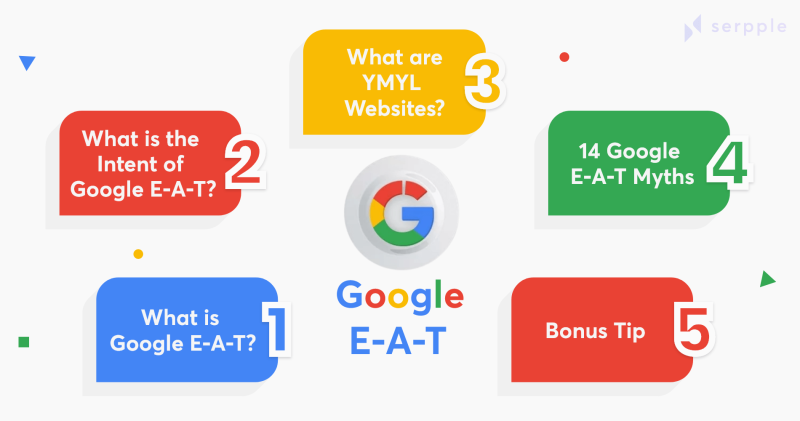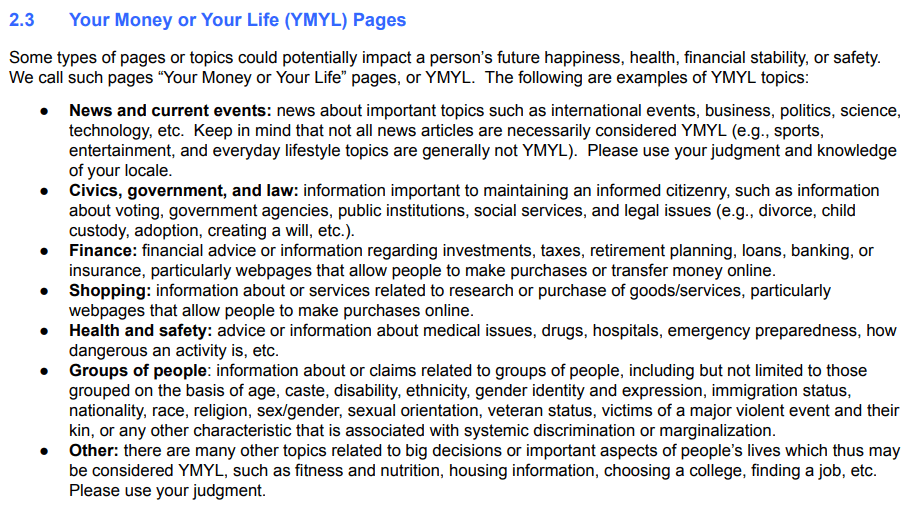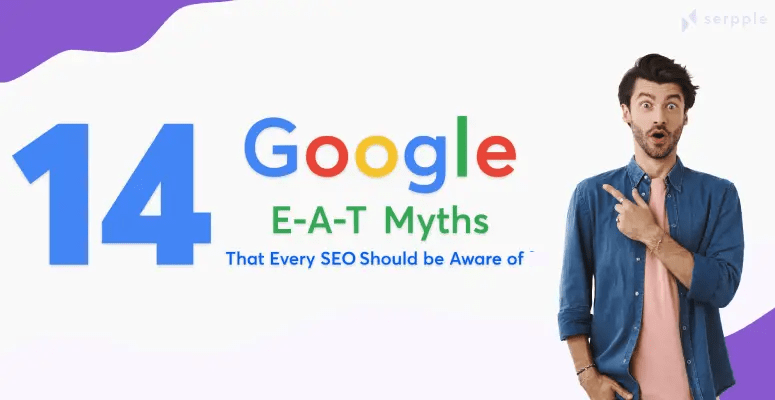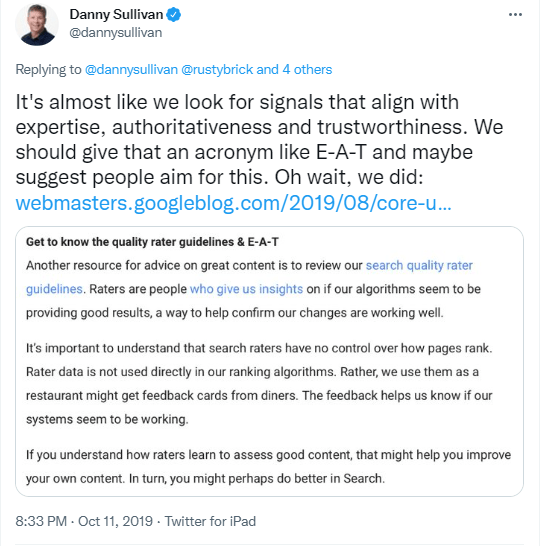If you came to this blog to learn more about eating, I’m actually very experienced but this is a post about Google E-A-T which the marketers and site owners should to know.
There is a ton of misinformation on the internet on Google E-A-T.
There has been a massive increase in Google searches for terms like “What is Google EAT algorithm”, “What are Google EAT Guidelines”, “What is EAT in digital marketing” and even “how to EAT google”.
Is Google EAT an Algorithm? Is it a Guideline? Or is it a part of Digital Marketing? Lets get answers for these and more of your questions.
We found 14 important Google E-A-T myths that every SEO should be aware of and also understand E-A-T even better.
Okay, let me start by saying that if you already have a pretty good understanding of what Google EAT is, then you can directly dive into the myths.
What is Google E-A-T?
E-A-T is the short form of Expertise, Authoritativeness, and Trustworthiness. It is a principle that Google uses to find how valuable the content is for users.
The term E-A-T was first mentioned in 2014 by Google Search Quality Guidelines. And later Google explained it clearly in 2019 on its Search Quality Evaluator Guidelines as follows
- E-A-T is the expertise of the creator of the Main Content (MC).
- The authoritativeness of the creator of the MC is the MC itself, and the website.
- The trustworthiness of the creator of the MC is the MC itself, and the website.
Therefore, focus more on Expertise, Authoritativeness, and Trustworthiness individually.
Expertise: Demonstrating your expertise is highly important in certain niches (e.g., legal, financial, medical).
The members at Google want the content on these sites to be written by subject matter experts (SMEs).
SMEs’ are the persons who possess adequate knowledge and understanding of the field to talk deeply about a specific topic.
Authoritativeness: When it comes to authority, Google considers reputation.
The stronger your reputation grows as a knowledge source within your circle of industry experts, the greater becomes your authority.
Authoritativeness is what happens when others (inside and outside of your industry) recognize the expertise.
Trustworthiness: Improve trustworthiness by highlighting the credentials of your content creators and the website.
Consider including your awards, testimonials, endorsements, and other trust factors.
Users have to feel they can trust all the information they find on your website.
Bottom line, Google E-A-T just wants to be able to trust your content so they can rank it higher in the search results.
Okay, then let’s move on.
Google E-A-T Guidelines
Google Search Quality Guidelines are also known as Google E-A-T guidelines because there is a lot of information stated about Google E-A-T in these guidelines.
In accordance, Google has mentioned 135 times in its guidelines about the Google E-A-T.
Do you wonder how these guidelines work to ensure the page’s quality?
Google has hired thousands of quality reviewing professionals assigned to check the page’s quality and ask them to give ratings to the pages with a number of factors. They are like,
- How well the content meets the purpose of the page
- Expertise, authority, and trustworthiness of the page
- Quality and information of the main content
- The reputation of the site
- User intent
- Usability
- Advertisement and monetization
- And much more
The primary factor that quality raters consider is to identify the page’s purpose and monitor how well the content helps to achieve that purpose.
Also, Google states that pages that are not helpful for the users, pages that spread hate, cause harm to the users, or pages providing misinformation or deceiving users with the content, will receive the lowest rating.
What is the Intent of Google E-A-T?
As we all know, Google always tries to satisfy its users with high-quality and relevant content that users find helpful and make it worth browsing Google.
That is the main reason why E-A-T was introduced.
The ultimate purpose of E-A-T is to give the users valuable content with expertise, authoritativeness, and trustworthiness.
Because looking for information on Google has become second nature for most of the world, it is critical for Google to provide results that help, satisfy and even delight their users.
Google understands the power that comes from being the world’s main source for information. This is especially important as users make important life decisions in categories like career, education, family, finances, relationships, relocation, self-destruction, self-development, and so on.
This is why Google introduced E-A-T.
Google also loves the content from “everyday expertise.” as it calls it.
Also, Google has mentioned that in the Guidelines,
Whether you agree with Google’s guiding principles or not, if you want to rank higher on the SERPs then you need to comply with these guidelines.
Produce the content and topic that always helps the users. Don’t make up stuff, don’t provide fluff, and don’t provide bad information. That will work against your E-A-T score.
Hopefully at this point you are getting a better understanding of how E-A-T works.
But many people on the internet misunderstand how to best implement Expertise, Authoritativeness and Trustworthiness.
Here are the 14 Google E-A-T myths that every website owner and SEO should be aware of.
14 Google E-A-T Myths:
1. Google Bots Test a Website’s E-A-T
Many people assume that your E-A-T score is calculated when a bot from Google visits your website.
The truth is that the system wasn’t created for Google bots to check a website’s E-A-T rating. Instead it was designed for their quality team to give feedback to Google to know if the results that are showing are from people who score high on the E-A-T scoring scale.
Google search quality guidelines are used during search quality evaluations.
Google has thousands of professional quality reviewers and they are assigned to manually review a set of web pages and also asked to submit feedback about the quality of the pages to Google.
2. Google Introduced E-A-T to Rank High-Quality Sites
This is not true.
This myth is like the chicken and the egg paradox.
People think Google introduced E-A-T to rank high quality websites, but in truth, the quality team looks at high ranking websites to make sure the algorithm is showing sites with high E-A-T scores.
Also, E-A-T is not meant to improve organic rankings, and it helps Google by providing valuable information about the site.
3. Google E-A-T is a Direct Ranking Factor
Considering the other Google ranking factors, which directly impact a page’s organic rankings, E-A-T is not a direct ranking factor in that same way.
A better explanation would be, Google’s quality rating team is going to look at your E-A-T factors and then decide if your site is worthy of showing at the top of the search results.
So while it is important in order to rank high, Google E-A-T is only indirectly affecting your rankings.
Most SEOs thinking to improve E-A-T will be key to improving their site’s organic rankings. There are much better SEO techniques (ie strong link building) that will actually improve your results.
Don’t expect your rank tracker software to show sudden hikes and spikes on your organic ranking improvements.
Because Google introduced E-A-T to evaluate the quality of the site with the help of quality raters.
Also, Google finds this E-A-T evaluation to improve its algorithm.
So it is not a ranking factor. Also, Expertise, Authoritativeness, and Trustworthiness are also not individual ranking factors.
4. E-A-T is an Algorithm
This one could be labeled as semantics, but Google does not have a single algorithm for E.A.T.
In fact it is a massive collection of small algorithms that run this process.
During the Q&A at Pubcon, here is the gist of what the webmaster trend analyst at Google Gary Illyes said,
E-A-T is a collection of millions of tiny algorithms that work in unison to spit out the ranking score. And, many of those baby algorithms search for signals in pages or content. In simple words, multiple algorithms conceptualize E-A-T.
5. There is Google E-A-T Score and YMYL Score
At the same Pubcon Q&A, Gary Illyes also confirmed that there isn’t any concept called the internal Google E-A-T score or YMYL score.
Google quality raters also do not have any Google E-A-T score to analyze in their evaluation.
6. Every Website has to Meet E.A.T. Standards
It totally depends on what type of site you are running and what type of content you are producing.
YMYL websites and topics should be a high priority to follow E-A-T standards because they can have such a large impact on users’ lives.
Google also uses the high page quality rating standards to evaluate YMYL sites.
Because YMYL sites and content directly impact readers’ happiness, health, financial success, or well-being.
Also a website or content about a hobby, such as photography or learning to play cricket requires less expertise and it can also have lower E-A-T standards in terms of analysis.
Also, websites other than YMYL having E-A-T would be nice.
Important Note: eCommerce development plays a crucial role here, as eCommerce sites are considered YMYL because they accept credit card information
7. E-A-T is New
Around the time of the August 1, 2018 core algorithm update, many SEO professionals claimed that E-A-T is a recent initiative by Google.
As mentioned at the starting of the blog, Google introduced E-A-T in the 2014 search quality evaluator guideline, and later it was updated in 2019.
This Google E-A-T misconception happened because most SEOs and website owners came to know the E-A-T topic recently. Therefore, it is not new anymore.
8. Author Biography is a Ranking Factor
One of the most important recommendations to gain E-A-T is to develop all the content with a biography of the author who wrote it.
This author biography or author page is to explain to users about the authors and why users can trust them and how the authors are experts on the specific topic.
One of the most common recommendations to improve E-A-T is to ensure all content contains a strapline for the author who wrote it, and ideally, each author has to have either a biography or a dedicated page explaining who they are and how they can be trusted with providing high-quality content.
In the Quality Guidelines, Google insists that quality raters should consider individual author biographies to determine the extent to which the authors are experts on the topics they write about.
Google is able to recognize established authors in its knowledge graph, but it may not have the same capabilities for recognizing all authors.
9. E-A-T Results are Instant
SEO factors like optimizing the meta tags and fixing other technical issues that will impact your results immediately.
But E-A-T is not like that case. Also, E-A-T is not a direct ranking factor too. Improving E-A-T gains your user’s trust and it takes a while to process those changes for search engines.
10. The August 1, 2018 Update was Officially Named “Medic” Update or Google “E-A-T” Update
As we already know, Google doesn’t release any official names for core algorithm updates, and the August 1, 2018 update was named as ”Medic” update by Barry Schwartz.
Also, some digital marketers refer to the update as a Google “E-A-T” update.
This leads to misleading information because the E-A-T is not the only issue when their site’s performance declines after the update.
11. The Core Algorithm Update Only Affects YMYL Sites, and E-A-T is the Only thing Causing Performance Decline for Websites.
This is the main Google E-A-T misconception that affects other site owners too.
The recent core updates affected YMYL sites and saw huge performance drops because of the lack of E-A-T and the lack of expertise of the authors.
Also, the algorithm update not only affected YMYL, but some other categories also felt the impact of those core updates.
Yes, since August 1, 2018, the recipe sites also saw enormous fluctuations after each core update.
Also, these sites have E-A-T and they are usually run by cooking enthusiasts who are all qualified to post recipes online.
And these recipe sites have site architecture issues, overwhelming ads, and poor page load times.
So, these other issues are responsible for the performance drops during that core updates.
12. Top Ranking Sites Always have High E-A-T
This is one of the common Google E-A-T misunderstandings that everyone trusts. And this is not true.
Because there are many other factors to rank higher on Google, also a website is ranked top on google for many reasons such as its many years of existence on Google, various off-page factors, and it has been optimized with rich metadata and so on.
So, if a website is ranked at the top on Google, it doesn’t mean it has a high E-A-T.
13. E-A-T is a Replacement for Any Other SEO Elements
Many SEOs thought if they have done E-A-T, there is no need for technical SEO or any other technical elements.
This is totally misunderstood because E-A-T is an additional one that Google came upon to find the quality of the websites.
14. All Website Owners Need to Focus on E-A-T
No, this point is not true. E-A-T is only for YMYL websites as Google mentioned in the guidelines.
Also, all website owners are able to focus on E-A-T, but it is not necessary as per Google’s guidelines.
Add Google E-A-T to your Content Marketing Strategy
Yes, you heard it right.
Whether you are running a YMYL or any other type of website, you have to pay attention to Expertise, Authoritativeness, and Trustworthiness.
Nevertheless, do not confine that these are the only ranking signals.
So try to add Google E-A-T to your content marketing strategy.
Of course, nothing is gonna be wrong if all the websites have E-A-T. In fact, it provides value to the users.
I hope, now you got all the Google E-A-T myths that are spreading on the internet.
Moreover, have you found any other Google E-A-T myths apart from these 14?
And, If you are looking for more SEO tips and tricks that work or an expert’s guidance, then let us know about it in our Faceboook Community.
Updated on 28, Feb 2023
Google E-A-T is now added with one more “E” which stands for “Experience”. This update highlights the importance of providing a positive user experience in addition to demonstrating expertise, authority, and trustworthiness in the website content. Check out this new blog on Google E-E-A-T or Double-E-A-T.
Published by
Adam White
Adam White is a 20+ year SEO professional who has optimized over 400 websites, built and sold over 20 internet and SaaS businesses all with SEO as the main traffic source. Follow him on Twitter/X
All stories by Adam White






